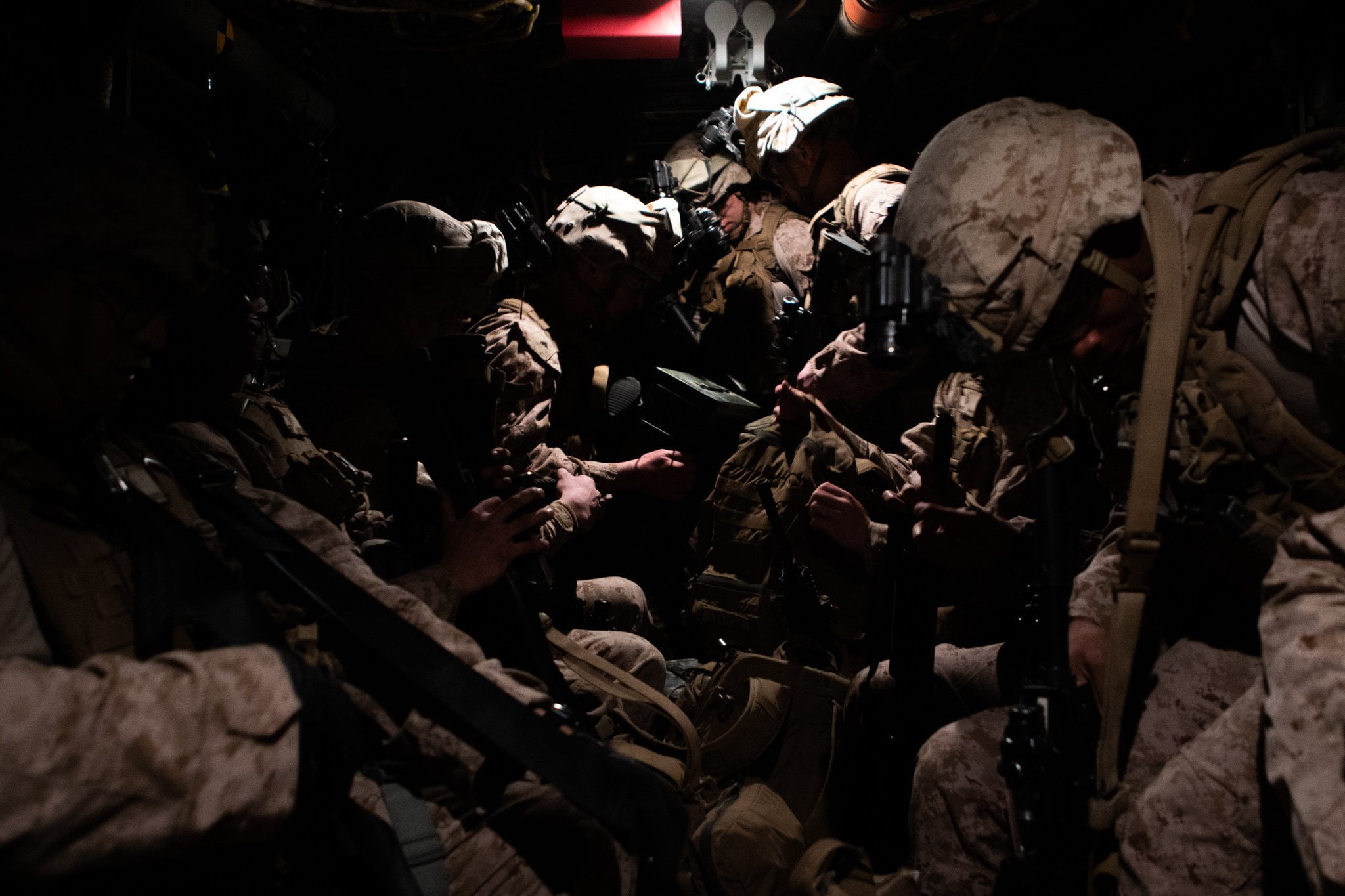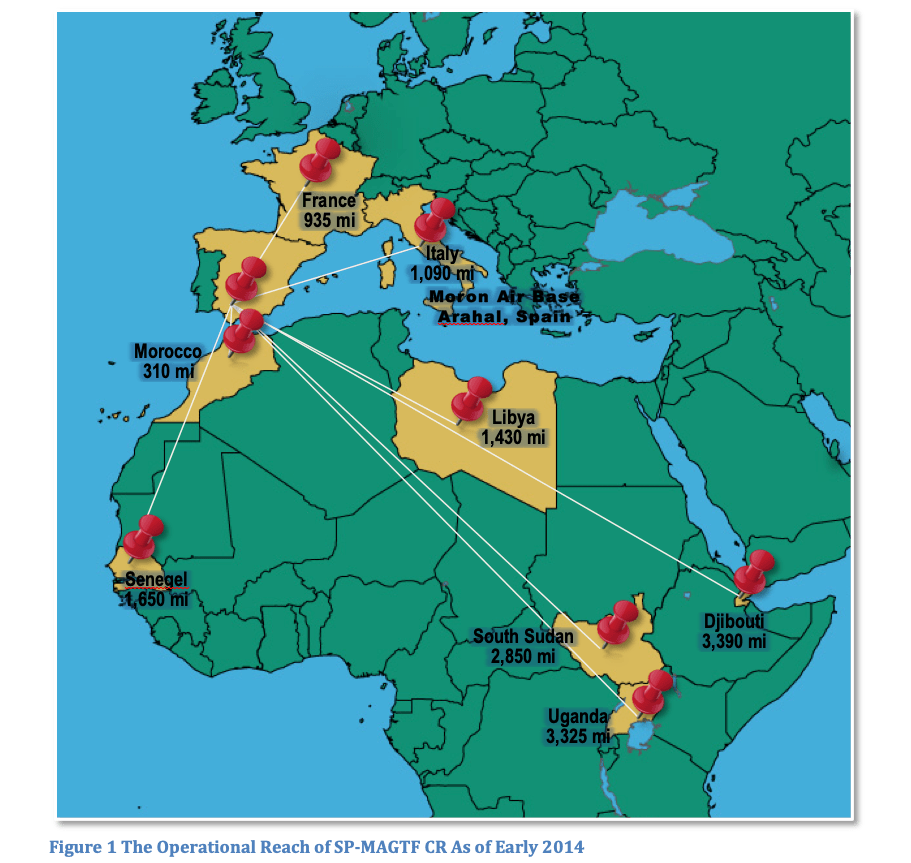The United States along now with the Japanese are the only tiltrotor enabled combat forces in the world.
This unique capability has been the backbone of innovations in distributed operations for the USMC for more than a decade of combat experience.
And the upgrading of the Osprey underway for the USMC and the inclusion of the Osprey now in the carrier aviation force will carry forward further innovations for the tiltrotor enabled combat force.
During a visit to Pax River last Fall, the path to further innovations was highlighted by Colonel “Squirt” Kelly.
Coming from the F-35 program provides Kelly with a leg up in terms of understanding what that aircraft can contribute to the Osprey and how, in turn, the V-22 aircraft needs to be modified to a more useful member of the integrated distributed force.
“With the Marine in the back of the Osprey working with his MAG-Tab (tablet), he or she is able to gain access to information flowing in from other platforms in the battlespace.
“And that is one key aspect of what we are focused on as we rework the program.
“Indeed, we have already done exercises at MAWTS-1 and VMX-1 where the Marine in the back of a V-22 can be looking on his MAG-TAB at a video generated from an H-1 or an F-35 operating in the same battlespace.”
And the V-22 working with the F-35 is a key element of being able for the Marine Corps/Navy team to work a Lightening carrier approach whereby an LHD like the USS America can operate a significant number of F-35s with accompanying Ospreys.
And this approach clearly is about changing dramatically the nature of what a Marine Corps assault force looks like as well as the combat effect it can achieve.
This next round of innovation is building on a significant period of innovation driven by the incorporation of the Osprey into the USMC approach to distributed operations.
A key example of which recently landed in the US embassy in Baghdad during the recent embassy crisis.
One can remember 1979 and the inability of the US to get inside the US embassy in Tehran to regain control of its embassy. This time it was different. Not just because it was in Baghdad, but the Osprey enabled CR-Special Purpose MAGTF has been created and operated for a number of years.

We have followed the Osprey from its initial deployments to the Middle East until the most recent innovations.
A clear milestone of change was the creation of an integrated distributed force, the Special Purpose MAGTF Crisis Response.
This force of C-130Js and Ospreys is designed to go rapidly to a crisis point and intervene in time to make a difference.
And it is capable of being integrated into a larger USMC or joint force as the tip of the spear.
It was designed in part to deal with embassy under siege crises but has expanded its envelope of operations.
But the events in Baghdad highlighted a core competence of the force.
Ben Werner highlighted the role of the force in the Baghdad events as follows:
The Pentagon is sending more forces, including roughly 100 Marines, to provide additional security to the U.S. embassy in Baghdad after a mob stormed the compound’s main entrance on December 31. 2019.
Marines assigned to Special Purpose Marine Air-Ground Task Force-Crisis Response-Central Command deployed to Baghdad from Kuwait, according to the Pentagon.
Additionally, an infantry battalion from the Immediate Response Force (IRF) of the 82nd Airborne Division are headed to U.S. Central Command, the Pentagon announced following an earlier version of this post.
“Approximately 750 soldiers will deploy to the region immediately, and additional forces from the IRF are prepared to deploy over the next several days,” the Pentagon said in a statement.
“This deployment is an appropriate and precautionary action taken in response to increased threat levels against U.S. personnel and facilities, such as we witnessed in Baghdad today.”
The protesters included members of the Shia group Kataib Hezbollah militia, according to an NPR report. Group members were protesting recent U.S. military airstrikes on five Hezbollah sites in Iraq and Syria.
A Look Back to the Juba Operation
The standup of the capability has provided a significant innovation for the USMC and for crisis response.
Murielle Delaporte visited the SP-MAGTF based in Spain in 2013, and her discussion with the USMC personnel provides a good sense of the approach to innovation represented by standing up the SP-MAGTF, as well as how tiltrotor capability provided the foundation for the innovation in concepts of operations.
In a 2014 article published in Leatherneck, Murielle Delaporte provided an overview of the Crisis Response unit with a focus on the effort in South Sudan. Interviews conducted in December 2013 at the Morón de la Frontera Air Force Base in Spain, where the SPMAGTF–CR temporarily has been deployed since April 2013.
In the following excerpt taken from the article, the author discusses the Juba Operation.
According to the Commanding Officer of the SP-MAGTF-CR in December 2013, Col. Scott Benedict:
“This force provides new capabilities where there has been a gap,” said Col Benedict.
Historically, we would provide this kind of capability of a Marine expeditionary unit [MEU], i.e., the Marine forces that are on ships.
Where there have been some gaps in the coverage of these ships, the Marine Corps created this force and intends to create others like it in order to fill those gaps.

So in that sense, it is a new capability, but the skills that we bring as a SPMAGTF are the same types of skills that Marines have always brought to the fight. In terms of comparing what we are doing now with what we have been doing in the past, my experience over the years has been that this is more the type of missions that Marines have done historically…..
However, what we have historically done is operate small units like this and provide very flexible and agile capabilities to respond to crisis. We have done it for years off amphibious shipping, and now we do it with the extended range capability of the V-22 which allows us to provide some very similar capabilities over the vast areas that we are responsible for.
The ACE commander, LtCol Freeland, who has been trained as both a CH-46 and a MV-22 pilot, said there is a paradigm shift due to the juxtaposition of the expeditionary vertical-landing capability of the V-22—especially useful if a runway or an airfield is not available or if it is necessary to land near the target—and the long legs brought by the KC-130J is able to generate on the theater.
“Both the MV-22 and KC-130J have worked together before in the past, but the way we are teaming them here is a little different: I think one of the best analogies is the tank-infantry team concept,” said Freeland.
We now share the whole mission together: It is shared mission management, shared functional responsibilities within the same flight.
Such a change is not overly difficult, but it is different, and we are expanding tactics, techniques and procedures to leverage the unique capabilities of each airframe.
You have, on the one hand, one V-22 aircraft going a distance, a good one but nothing incredible—let’s say 350 miles—and land vertically anywhere, and you have, on the other hand, one KC-130J which can fly thousands of miles, but [has] to land on a runway.
Now you put the two of them together, and you can take this team thousands of miles away and land anywhere.
This is a very significant paradigm change.
We bring agility and task organize the Ground Combat Element to go anywhere we need to quickly.
“The work we have been doing traditionally in Africa has been done off amphibious shipping,” Col Benedict added.
We would send a ship up and down the coast, and we would operate.
So, this is the same idea that we would not have a permanent presence, but different aircraft.
The capability that we have now is unique, as this pairing of the MV-22 and the KC-130J gives us the type of ranges that is necessary to be able to operate in Southern Europe, while still being able to reach all the operational areas that are necessary in Africa.
That is what I meant by bringing together the old and the new, because when the Marine Corps was envisioning bringing the V-22 forward as a capability, we envisioned this kind of distance to employ the force.
We just have not been [until now] in a position to take advantage or to have to use that capability.
In this particular mission and with this particular force in the area we are responsible for, we are employing the V-22, the KC-130J and a task-organized ground force at the distances we envisioned when this aircraft was designed.
That is revolutionary.
The Marines also are going back to some geographic roots as well, since they have had a long history in West Africa during the Cold War and in the ’90s and early 2000s.
Benedict added,
Well before the current ‘post 9/11,’ it has been episodic because we do exercises and theater security cooperation where we partner with nations, so we learn from them and they learn from us, keeping in mind that we might work together in the future for a common goal.
However, we have not based there.
We have been doing these operations for years, and it has paid dividends when we had to do ‘provide support’ for different countries on the continent.
Another MAGTF, called SPMAGTF Africa, is, in fact, more dedicated to training and partnering with African forces and has been building those relationships for several years on the continent.
This long-lasting effort has proven an essential part in the success of the recent evacuation of U.S. and non-U.S. citizens from South Sudan, with the ability to rely on neighboring partners such as Uganda, which at the time of the crisis actually was involved in a pre-planned small logistics exercise with SPMAGTF Africa, while USAFRICOM also was overseeing an aircraft mission flying 850 Burundians as peacekeepers in Central Africa.
Juba, South Sudan, also has been a case in point demonstrating the revolutionary capability of the pairing between the MV-22B and the KC-130J with the longest-range insert ever accomplished by the SPMAGTF–CR.
As the domestic situation worsened in South Sudan on Dec. 15, 2013, a decision was made to evacuate part of the personnel from the U.S. Embassy in Juba. The mission was given to USAFRICOM, which assigned its execution to the Combined Joint Task Force-Horn of Africa based in Djibouti. It was under the authority of the CJTF-HOA commander, Brigadier General Terry Ferrel, USA, that on Dec. 22, 2013, SPMAGTF–CR repositioned about a third of its force—160 Marines and sailors—from Morón de la Frontera to Camp Lemonnier, Djibouti.
Approximately 12 hours later, a platoon-size element (about a third of that very force) was flown by a KC-130J to Entebbe, Uganda, in order to be better postured to support operations at the U.S. Embassy in Juba.
“Within 60 hours of receiving the execution order, SPMAGTF–CR inserted forces more than 4,000 nautical miles from Spain to Djibouti, Uganda and South Sudan,” said Capt Sharon Hyland, SPMAGTF–CR public affairs officer.
“The distance from Spain to Djibouti is equivalent to a flight from Anchorage, Alaska, to Miami, Florida. This was the longest-range insert to date for this force and was a testament to the organic aviation assets and our task organized force which enables us to accomplish our mission.”
On Jan. 3, 2014, a squad-size element of Marines from SPMAGTF–CR successfully evacuated more than 20 personnel from the U.S. Embassy in Juba, via a KC-130J in coordination with the East African Reaction Force (EARF).


